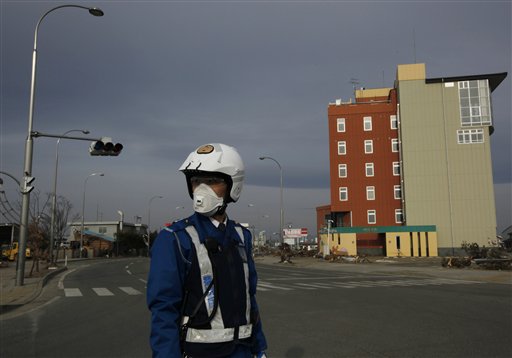 Sendai, Japan – A strong aftershock ripped through northeastern Japan, killing two, injuring dozens and piling misery on a region still buried under the rubble of last month’s devastating tsunami.
Sendai, Japan – A strong aftershock ripped through northeastern Japan, killing two, injuring dozens and piling misery on a region still buried under the rubble of last month’s devastating tsunami.
Subscribe to our Daily Roundup Email
The quake late Thursday was the strongest tremor since the March 11 jumbo and did some damage, but it did not generate a tsunami and appeared to have spared the area’s nuclear power plants. The Fukushima Dai-ichi complex — where workers have been frantically trying to cool overheated reactors since they lost cooling systems last month — reported no new abnormalities. Other facilities retained a connection to the grid or switched to diesel generators after the 7.1-magnitude quake knocked out power to much of the area.
Many people in the area have lived without water and electricity for nearly a month, and the latest tremor sunk more homes into blackness: In total, around 3.6 million households — about 60 percent of residents in the area — were dark Friday, said Souta Nozu, a spokesman for Tohoku Electric Power Co., which serves northern Japan.
Five conventional plants in the area were out, and it was not clear when power would be restored, he said.
Matsuko Ito, who has been living in a shelter in the small northeastern city of Natori since the tsunami, said there’s no getting used to the terror of being awoken by shaking.

“I was almost as scared as much as last time,” said the 64-year-old while smoking a cigarette outside. “It’s enough.”
She said she started screaming when the quake struck around 11:30 p.m.
“Something has changed,” she said. “The world feels strange now. Even the way the clouds move isn’t right.”
Thursday’s quake initiated a tsunami warning of its own, but it was later canceled. Two people were killed, fire department spokesman Junichi Sawada reported Friday. A 79-year-old man died of shock and a woman in her 60s was killed when power was cut to her oxygen tank. More than 130 people were injured, according to the national police agency.
The temblor’s epicenter was in about the same location as the original 9.0-magnitude tremor, off the eastern coast and about 40 miles (65 kilometers) from Sendai, an industrial city on the eastern coast, according to the U.S. Geological Survey. It was strong enough to shake buildings for about a minute as far away as Tokyo, about 200 miles (330 kilometers) away.
At a Toyota dealership in Sendai, most of a two-story show window was shattered, and thick shards of glass were heaped in front of the building. Items fell off store shelves and a large automated teller machine crept across the floor at a FamilyMart convenience store.

Police directed cars through intersections throughout the city on Friday because traffic lights were out. Small electrical fires were reported.
While the city is far enough inland that it largely escaped tsunami damage, people there lived without regular services for weeks. Within an hour of Thursday’s quake, they rushed convenience stores and cleared shelves of ice, water and instant noodles — items that were in short supply after the bigger quake.
The operator of the tsunami-ravaged Fukushima Dai-ichi plant said there was no sign the aftershock had caused new problems there. Workers briefly retreated to a quake-resistant shelter in the complex and suffered no injuries.
After the March 11 quake knocked out power in the region, the wave flooded the plant’s diesel generators, leaving the complex without any electricity. Workers have been struggling to stem a tide of radiation since, using makeshift methods to pump cooling water into the reactors. That work continued uninterrupted after the latest quake, according to Japan’s Nuclear and Industrial Safety Agency.
Other facilities along the northeastern coast remained connected to a power source Friday, and the agency said they were all under control. Backup generators kicked in at two — Rokkasho and Higashidori.
At a third north of Sendai — which has been shut down since the tsunami — one of three power lines was supplying electricity, and radiation monitoring devices detected no abnormalities. The Onagawa power plant’s spent fuel pools briefly lost cooling capacity, but it resumed because a power line was available for electricity.
“It’s the way it’s supposed to work if power is lost for any reason,” said David Lochbaum, director of the nuclear safety project for the U.S.-based Union of Concerned Scientists.

If I see one more comment about the two drug smuggling boys, I am going to throw up. If you want an explanation for why Japan is getting all these earthquakes and tsunamis, it’s simple. Japan is located over a bunch of fault lines. Science.
If Hashem is going to send a bunch of earthquakes and tidal waves to punish a people for their awful sins, don’t you think Gaza would be a better choice to destroy?
Japan “choped a potch fun Gut” for something as yet unknown to us. Perhaps they were next in line to “support Palestine taking Jerusalem as its Capitol” and would have provided major financing?. Or perhaps it is the final “potch” for supporting the Nazis in thier killing of Yiddishe kinder? But whatever it is, rest assured there is a G-d in the world and he planned this down to the nitty-gritty of “Mi yicheh u”mi yamus, Mi b’Mayim u’Mi b’Aish”.